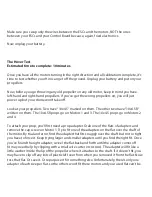
rare, but yes, it does happen. NEVER, EVER leave a LiPo battery on a charger unattended.
Many suggest never charging them indoors, and while that’s not always possible, if you
must charge them in your house or garage, be sure that you are always in the same room
as the charging LiPo and never put it near anything flammable, like drapes, bedding, rugs,
furniture, household chemicals, or containers that have been used for flammables like
gasoline, propane, or kerosene. Inside or outside, NEVER leave batteries charging overnight.
When you’re not using your LiPo, keep it in a battery-safe bag in a fire-safe battery box.
Never leave them out loose and NEVER EVER put a bunch of them together in a non-LiPo-
safe container.
Do not run your LiPo batteries completely out of charge when you’re using them. This
damages the batteries and increases the danger.
Regularly inspect your LiPo batteries. If you ever find one of your LiPos is damaged, or if one
is puffed up like a little balloon, DO NOT USE IT. Fully discharge it and dispose of it properly.
Do some research on the care and feeding of LiPo batteries so you know what to do and
what not to do. We don’t want to lose one of our Hiro family due to a battery.
Second, flying etiquette. It’s important. You now are a part of the flying community, and
you now have a great responsibility to know how to fly safely and properly. There’s a lot of
scrutiny of drones and their owners. So before you head out on your first flight, you should
know and abide by the suggested guidelines of the Federal Aviation Administration and the
Academy of Model Aeronautics.
To learn about these guidelines, which will keep you and others safe, visit http://
knowbeforeyoufly.org and http://www.modelaircraft.org/files/540-c.pdf.






























